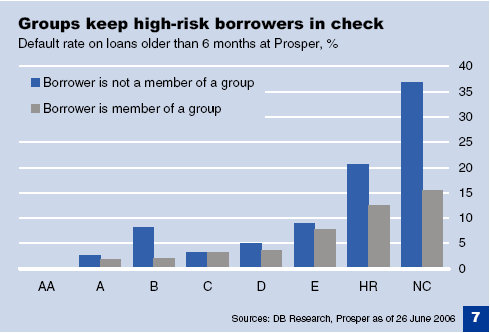The new study "Dynamic Learning and Selection: The Early Years of Prosper.com" by Seth Freedman and Ginger Zhe Jin, both at the Department of Economics, University of Maryland analyses Prosper data in a time frame from April 19th 2006 to December 31st 2007.
The study analyses the development of the Prosper.com marketplace and how lenders refined their strategies as a result to own experiences and changed settings.
They write:
Overall, we conclude that Prosper is evolving from a comprehensive market to a market that primarily serves the borrowers who have access to traditional credit. This implies that Prosper will compete head-to-head with the traditional banks rather than pick up a missing market. Assuming away any cost in information processing, we estimate that the average rate of return of a Prosper loan is 6% if Prosper loans continue to perform according to what we have predicted from their existing performance. From the lenders point of view, this number compares favorably to 6-month certificate of deposit and 3-year Treasury bill, but less favorably to the rate of return implied by the S&P 500 in the same time period.
Other findings are that high interest loans yield lower returns due to high default rates and that the probability for defaults of Prosper loans peak at month 10 and the edge down.
The main uses of Prosper loans are:
33% of all previous Prosper listings have mentioned credit card consolidation, which is higher than the mention of business (23%), mortgage (15%), education (22%), and family purposes (20%) such as weddings.
Cited from the conclusion chapter of the study:
The first two years of Prosper has enlivened the concept of P2P lending, but the road towards success is full of challenge. While it is tempting to expect P2P lending to alleviate credit rationing for near- or sub-prime risks, we find Prosper evolving from a comprehensive market toward a market that primarily serves borrowers who have access to traditional credit. This implies that Prosper will compete head-to-head with the traditional banks, rather than pick up a missing market. This pattern is not unique to Prosper. …
How can Prosper compete with traditional banks? Our study suggests that the microfinance approach, as implemented through Prosper groups, has failed to select good risks or enhance loan performance. But on the up side, lenders are learning fast about the pitfalls of P2P lending thanks to the transparency of Prosper. Our calculation suggests that, if the loans continue to perform as what we have predicted from the market performance, Prosper loans could yield an average return of 6%.
See related post on the Prosper blog.

